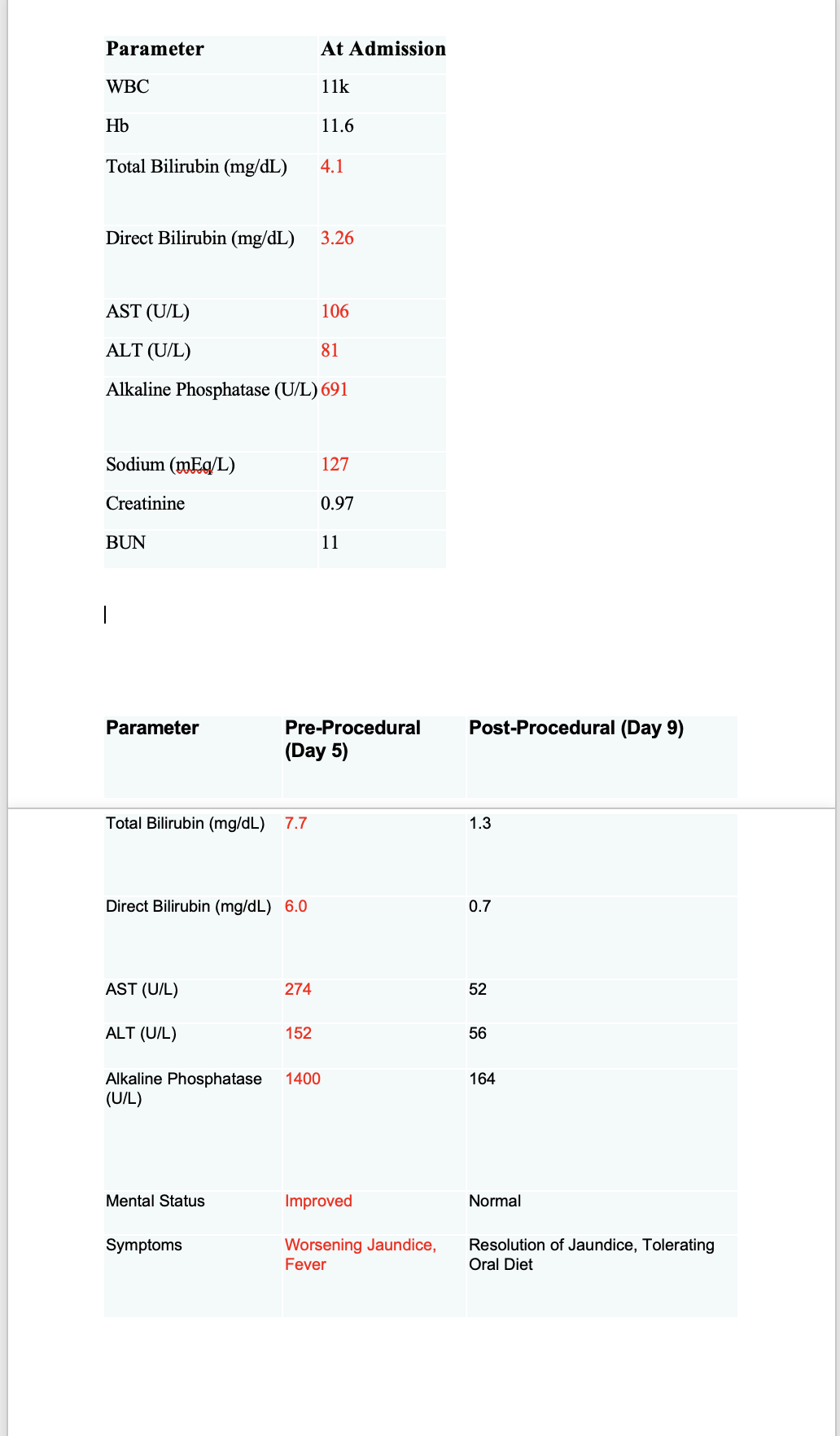Sunday Poster Session
Category: Interventional Endoscopy
P1443 - Overcoming ERCP Limitations: A Case of EUS-Guided Biliary Stenting in Pancreatic Cancer-Induced Obstructive Jaundice
Sunday, October 26, 2025
3:30 PM - 7:00 PM PDT
Location: Exhibit Hall

Simardeep Singh, MBBS
MedStar Georgetown University Hospital
Baltimore, MD
Presenting Author(s)
Simardeep Singh, MBBS1, Saurav Kini, MBBS2, Gurleen kaur, MBBS3, Boniface Mensah, MBChB, MPh1, Abhinav Sankineni, MD4
1MedStar Georgetown University Hospital, Baltimore, MD; 2Tufts Medical Center, Boston, MA; 3Government Medical College and Hospital Amritsar, Balitmore, MD; 4MedStar Georgetown University Hospital, Baltimore, WA
Introduction: Pancreatic cancer frequently leads to malignant biliary obstruction, often managed with endoscopic retrograde cholangiopancreatography (ERCP). However, ERCP is not always feasible, particularly in cases with duodenal stenosis. Endoscopic ultrasound (EUS)-guided antegrade biliary stenting (EUS-AGS) has emerged as an alternative approach. This case illustrates the successful use of EUS-AGS in an 80-year-old male with pancreatic cancer-induced obstructive jaundice where ERCP was not possible.
Case Description/
Methods: An 80-year-old male with a history of pancreatic adenocarcinoma presented with fever, chills, altered mental status, and progressive jaundice. Laboratory findings included an elevated total bilirubin of 4.1 mg/dL, which worsened to 7.7 mg/dL, alongside a rise in AST/ALT and alkaline phosphatase. Imaging revealed a periampullary mass causing severe biliary obstruction and duodenal stenosis, precluding ERCP. After a failed ERCP, EUS-AGS was performed via a transgastric puncture of the left intrahepatic bile duct using a 19-gauge needle. A guidewire was successfully passed across the biliary obstruction, followed by dilation and placement of an uncovered metal stent in the common bile duct. Post-procedure, the patient showed marked clinical and biochemical improvement, with bilirubin levels decreasing to 1.3 mg/dL. He was discharged without complications and continued outpatient follow-up.
Discussion: EUS-AGS is gaining recognition as a viable alternative to percutaneous transhepatic biliary drainage (PTBD) and ERCP when conventional methods are unfeasible. Compared to PTBD, EUS-AGS offers lower complication rates, improved patient comfort, and reduced hospital stays. This case reinforces the safety and efficacy of EUS-AGS for managing distal malignant biliary obstruction, particularly in the setting of gastric outlet obstruction.

Figure: Labs trend during the hospital course

Figure: Imaging Pre- and Post procedure
Disclosures:
Simardeep Singh indicated no relevant financial relationships.
Saurav Kini indicated no relevant financial relationships.
Gurleen kaur indicated no relevant financial relationships.
Boniface Mensah indicated no relevant financial relationships.
Abhinav Sankineni indicated no relevant financial relationships.
Simardeep Singh, MBBS1, Saurav Kini, MBBS2, Gurleen kaur, MBBS3, Boniface Mensah, MBChB, MPh1, Abhinav Sankineni, MD4. P1443 - Overcoming ERCP Limitations: A Case of EUS-Guided Biliary Stenting in Pancreatic Cancer-Induced Obstructive Jaundice, ACG 2025 Annual Scientific Meeting Abstracts. Phoenix, AZ: American College of Gastroenterology.
1MedStar Georgetown University Hospital, Baltimore, MD; 2Tufts Medical Center, Boston, MA; 3Government Medical College and Hospital Amritsar, Balitmore, MD; 4MedStar Georgetown University Hospital, Baltimore, WA
Introduction: Pancreatic cancer frequently leads to malignant biliary obstruction, often managed with endoscopic retrograde cholangiopancreatography (ERCP). However, ERCP is not always feasible, particularly in cases with duodenal stenosis. Endoscopic ultrasound (EUS)-guided antegrade biliary stenting (EUS-AGS) has emerged as an alternative approach. This case illustrates the successful use of EUS-AGS in an 80-year-old male with pancreatic cancer-induced obstructive jaundice where ERCP was not possible.
Case Description/
Methods: An 80-year-old male with a history of pancreatic adenocarcinoma presented with fever, chills, altered mental status, and progressive jaundice. Laboratory findings included an elevated total bilirubin of 4.1 mg/dL, which worsened to 7.7 mg/dL, alongside a rise in AST/ALT and alkaline phosphatase. Imaging revealed a periampullary mass causing severe biliary obstruction and duodenal stenosis, precluding ERCP. After a failed ERCP, EUS-AGS was performed via a transgastric puncture of the left intrahepatic bile duct using a 19-gauge needle. A guidewire was successfully passed across the biliary obstruction, followed by dilation and placement of an uncovered metal stent in the common bile duct. Post-procedure, the patient showed marked clinical and biochemical improvement, with bilirubin levels decreasing to 1.3 mg/dL. He was discharged without complications and continued outpatient follow-up.
Discussion: EUS-AGS is gaining recognition as a viable alternative to percutaneous transhepatic biliary drainage (PTBD) and ERCP when conventional methods are unfeasible. Compared to PTBD, EUS-AGS offers lower complication rates, improved patient comfort, and reduced hospital stays. This case reinforces the safety and efficacy of EUS-AGS for managing distal malignant biliary obstruction, particularly in the setting of gastric outlet obstruction.

Figure: Labs trend during the hospital course

Figure: Imaging Pre- and Post procedure
Disclosures:
Simardeep Singh indicated no relevant financial relationships.
Saurav Kini indicated no relevant financial relationships.
Gurleen kaur indicated no relevant financial relationships.
Boniface Mensah indicated no relevant financial relationships.
Abhinav Sankineni indicated no relevant financial relationships.
Simardeep Singh, MBBS1, Saurav Kini, MBBS2, Gurleen kaur, MBBS3, Boniface Mensah, MBChB, MPh1, Abhinav Sankineni, MD4. P1443 - Overcoming ERCP Limitations: A Case of EUS-Guided Biliary Stenting in Pancreatic Cancer-Induced Obstructive Jaundice, ACG 2025 Annual Scientific Meeting Abstracts. Phoenix, AZ: American College of Gastroenterology.
